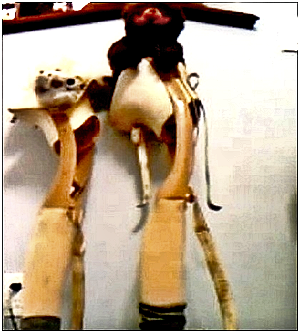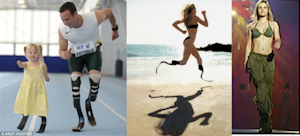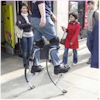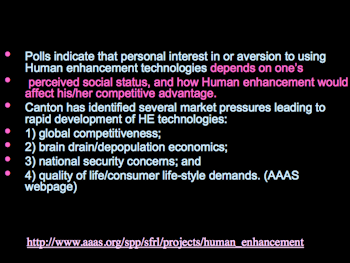The Realpolitik of Ableism
Prof. Gregor Wolbring
This article was adapted from a lecture given by Gregor Wolbring, Ph.D., Assistant Professor in Community Rehabilitation and Disability Studies, Community Health Science, Faculty of Medicine at the University of Calgary, Canada to the 7th Annual Workshop on Geoethical Nanotechnology, July 20, 2011, at the Terasem Island Amphitheatre in Second Life.
Dr. Wolbring discusses the unequal distribution of abilities inherent in biological structures and the governance necessary to our future of evolving human enhancement and abilities.
My agenda is not to talk too much about the technology, but show you a few pictures to demonstrate where technology is going and what technologies are coming down the pipeline. I wish to introduce you to a theoretical framework that can be used to look from a different lens, namely ableism at technological advancements, including nanoscale sciences and technologies.
Ableism influences science technology, and visa versa. Science technology permits new ability preferences and, at the same time, new ability preferences lead to new science and technology desires. It's really a dynamic setup where they influence each other and how we deal with ability; it's a governance issue. I want to simply show you some examples of ableism.
Part of this is coming from a different study field, namely ability studies; what is the scope of therapeutic? You will see at the end that therapeutic is not written in stone by any means at all. I will focus mainly on body-linked interventions, which will very likely leap forth in advancement given nanoscale science technology. I will then focus on changing science and technologies.

These are my legs – you can see they are now mostly used for teddy bears, but I actually wore them when I did my PhD. That tells you how old I am – by these legs. Now we have a little more cutting-edge stuff running around.

Credit: www.universalsports.nbcsports.com
These of course, are the cheetah legs of Oscar Pistorius [1], the South African Para Olympic athlete who wanted to run in the Olympics and wear his legs, but they were labeled as techno-doping devices because they were seen to give him an unfair advantage against Olympic runners. He is by no means the only one who is wearing them. The woman on the beach is Aimee Mullins [2] who is a model aside from being a Para Olympian. With Oscar Pistorius, you see a small child about two or three-years old who is wearing Cheetah legs.
People of all ages are already starting to use these cheetah legs that are so powerfully made of the nano carbon fiber, which is part of the setup. The photo below is in essence the non-amputee version where you also have springs and you just put them onto the average legs. It really wouldn't do to amputate your legs just to get these cute little cheetah legs. The other photo is of an exoskeleton which is developed by many different companies, from San Francisco Bionics to the Sarcos Company, and are developed for soldiers - to increase their abilities, such as stamina, carrying weight, and so on.
 |
 |
Credit:www.universalsports.nbcsports.com
Credit: http://jotman.blogspot.com/2010/11.html
These exoskeletons are also developed as therapeutic devices for disabled people. The boundary as to what is therapeutic and what is not is very vague, not very definable.
This photo depicts a person of the future where the legs look slightly different, more kangaroo-like and springy – we're already getting there. This shoe company is using images like this of moving beyond current capabilities.

Credits: http://www.footy-boots.com
 |
Of course, humans are not the only ones being enhanced. This is a living moth developed by DARPA, a defense research agency in the US. This is a moth built with some remote control elements where |
one can fly this moth into many kinds of areas. Obviously, this is not what a moth is supposed to do ability-wise by its genetic code, but as with humans, we can augment a non human living organism. [Photo Credit: http://www.liveleak.com/view?i=810_1205843044]

Credit: http://biogenesislab.blogspot.com
In this graphic, we see the Audeo from Ambient, which is a sub-vocal speech device. If you go to their website at http://www.theaudeo.com, you'll find something you put against your larynx on the outside, it's non-invasive, and without moving your mouth, the speech device can interpret your larynx movement without you having to move your mouth by transferring it over to the computer and converting it to a voice. You can make phone calls with it; you can also control a wheelchair with it. This device was developed at the Rehab Institute of Chicago [3] and was originally developed for a therapeutic purpose, but you can easily envision it can be used for other purposes like security details, which was the original push behind sub-woofer speech devices.
Brain-machine interfaces exist in many forms. There is a group that is invasive, we see this mostly on US television – we see a monkey remotely moving a robotic arm. There is another version that is not invasive – that you just put on your head allowing you to do certain things. The first commercial version of that is from Emotiv Systems [4] which is envisioned to thought-control computer games such as World of Warcraft; something used in the gaming industry can later lead to certain ability expectations.
In essence, we're developing artificial replacements for almost every body part or add to a certain type of ability. For example, today's hip implant has sensor systems integrated so you can remotely tell when a new replacement is necessary by measuring the output against what is viewed as acceptable. We hear a lot about the different developments, about the retina for people who cannot see, but that's still a while off. Once they work, none of the developers see a reason why they have to stop at the ability version of the normal body equivalent which is defined by essence ability, which is defined by genetic code. You can add all kinds of things to it and have all kinds of new abilities.

Hip prosthesis with integrated sensorics.
© Fraunhofer IPMS
Credit: http://www.ipms.fraunhofer.de
The "Ilulissat Statement [5] Synthesizing the Future a vision for the convergence of synthetic biology and nanotechnology" talks about 'cyborg cells'. There is no technical reason the work performed on non mammalian Cyborg cells should not be applicable to human cells. Nanosynbio moves the cyborgization towards the cellular level and below. The nanoscale cyborgization of cellular components and subcellular structures is the logical extension of the organ and body part cyborgization.
There are many applications one can envision once miniaturization takes further place; energy isn't an issue anymore. It is conceivable we would go down this road when nanoscale science comes into play. Smart dust [6] will be so small and will be able to be placed anywhere. It can be part of the world or it can be part of an organ without having to take up much space.
"...synthetic biology is nanoscale because genes and genetic developments are what happen on the nanoscale..." I would say synthetic biology is nanoscale because genes and genetic developments are what happen on the nanoscale, but it's really that people want to design stuff and not being limited by what our genetic code is telling us at the moment. Various people feel that we can redesign all we know, create artificial genomes and even genomes from scratch and other things in the media. If I were looking far, far into the future, one could easily see the merging of synthetic genomics where you synthesize a genome as you see fit with an artificial womb where you simply grow the very entity you just generated a genome of. That's obviously not here yet, but we can envision that. It will have profound implications if this option ever comes to pass.
Longevity and immortality technology is another area envisioned. You can see proponents in this area trying to change the narrative by labeling death as a disease, which means it can be conquered, and so forth.

What drives science and technology advancements? Ableism is a concept that is overlooked generically in any policy debate, including science and technology policy debates. Ableism was actually conceptualized by the disabled people rights movement of the 60s and 70s. It was intended to parallel sexism or racism. In essence, it highlighted the obsession or preference for species-typical body abilities and then the negative treatment, the negative perception of the body labeled as being below the norm or below the species' typical. They coined ableism to highlight a discourse where you are expected to have a normative body and if you don't have that you are seen as deficient. At that time, they obviously weren't thinking beyond the norm, just below the norm.
However, ableism is actually a much broader concept. Individuals, households, communities, groups, sectors, regions, countries and cultures cherish and promote certain abilities while viewing others as non-essential (favoritism of abilities). Favoring certain abilities often morphs into ableism where one not only cherishes certain abilities but where one sees certain abilities in oneself or others as essential and labels real or perceived deviation from or lack of these essential abilities as problematic.
Ableism leads to an ability based and ability justified understanding of oneself, one's body, and one's relationship with others of one's species, other species and one's environment. Ableism can be positive or negative.
As an individual, I make ability decisions on a daily basis, as in: I want the ability to buy certain things, or the ability to live in a certain place, or to interact with others within Second Life [7]. Cultures have different understandings of what abilities are seen as less essential. Countries have very different ability preferences; China might have different ones than Germany, England or elsewhere. In the end, ableism goes much beyond the bodies. Consumerism is a form of ability preference – to have the ability to consume. Others want the ability to be productive, as a country, or an individual. Competitiveness is another ability that is cherished; the list is endless.
"We also use cognition to justify speciesism." Ableism is the preference for certain abilities; it's not negative per se. It could be positive depending on how the social structure deals with or depends on it. We could have an ableism that prefers equity within a social structure and then the people who prefer that would say this is a positive, but ableism is and was also used in a negative way. Women in Western countries were for a long time denied the right to vote with the argument that they do not have the ability of being rational but rather are irrational. We use cognition often to justify racism stating that some ethnicity or race is more cognitively able than others. We also use cognition to justify speciesism. We say we can use animals in different ways because they're not cognitively able. We see a coming of youthism and ageism that's quite interesting actually, in the dynamic. We increasingly see elderly with age related deteriorations to exhibit youthism asking for restoration of abilities of their youth. One form of ageism is the negative treatment of the elderly because they do not have the abilities of their youth anymore. Many elderly might adhere to youthism as a means to escape ageism treatment.
Casteism [8] shows that if you belong to a different caste, automatically certain abilities are linked to you. We could go on and on with that, but it's just to show you that ableism is a powerful lens on a particular framework. Everything is impacted by an ability one cherishes as a culture, and on the other hand, depending on how you perceive what you see on the slide, you might even change what abilities you cherish.
Let's move to enhancements, which is more futuristic. I chose this because of the Nano Bio Info Cogno (NBIC) Conference of 2001 [9]. I was part of that conference, and they could have chosen anything, they could have said for the advancement of mankind, to fight hunger, or whatever – but they chose human improvement. They'd chosen to move beyond the typical human. How this was sold to the politicians is very interesting. The NBIC report used the term 'productivity' over sixty times, the term 'efficiency' fifty-four times, and the term 'competitiveness' twenty-nine times. That's how you get a politician on your side.
In 2008, Nature [10] published the results of a survey taken with 1,427 individuals on cognitive enhancement. 79% felt that healthy people should be allowed to take cognitive enhancers. When asked whether healthy children under the age of sixteen should be restricted from taking these drugs, unsurprisingly, the majority of respondents (86%) said that they should. Of those 86%, one-third stated they would feel pressure to give cognition-enhancing drugs to their children if other children at school were taking them. It's like the Nike shoes all over again where a parent says my kid cannot perform properly if other children have them and theirs doesn't; it's the competitiveness of the school system which would drive people to move off the scale.
From the American Association for the Advancement of Science [11] (AAAS) conference, you can see what drives people. It depends on competitiveness, one's position or a desired quality of life, and even national security (definitely a problem in the US). Polls indicate that personal interest in or aversion to using Human enhancement technologies depends on one's perceived social status, and how Human enhancement would affect his/her competitive advantage. Canton [12] has identified several market pressures leading to rapid development of Human enhancement technologies:
• Global competitiveness;
• Brain drain/depopulation economics;
• National security concerns; and
• Quality of life/consumer life-style demands. (AAAS webpage)
(http://www.aaas.org/spp/sfrl/projects/human_enhancement)
"Anyone not beyond species-typical abilities will be labeled as 'impaired'..."We are moving beyond what we see as species-typical abilities. In the future we will be able to add abilities that go far beyond our genetic code. It is easily feasible that we are looking at a preference or favoritism for beyond species-typical abilities, another form of ableism. Anyone not beyond species-typical abilities will be labeled as 'impaired' as in a diminished state of being with the accompanying discriminatory and other negative reactions as not part of the norm. We see a new group, what I call the Techno Poor/Unenhanced impaired and Disabled who do not have access to the newest upgrades to the body. You can see all kinds of things changing. "Medical health" is characterized as the normative species-typical functioning of biological systems whereas disease/illness is defined as the species-typical sub-normative functioning of biological systems. Rehabilitation is a treatment or treatments designed to facilitate the process of recovery from injury, illness, or disease to as normal /optimum a condition as possible.
However the enhancement model of health is the concept of having obtained maximum (at any given time) enhancement/improvement of one's abilities, functioning and body structure beyond species typical boundaries. All Homo sapien bodies – no matter how conventionally "medically healthy" – in that model are seen in ill health and in need of constant improvement. One could envision many changes to the health care system to come if we move toward this new meaning of health. For example, you can envision a health insurance system that focuses not on people having a means to afford cures towards the species-typical after diseases, but people might seek health insurance so they have means to afford beyond the species-typical upgrades to their bodies. If you don't have the money for an upgrade, such might be first covered by a private, complimentary insurance. This is not really being debated at the moment, but eventually the system might decide that a given structure is better for society and make a publicly available health insurance to cover these enhancements so one may possibly upgrade themselves. It all depends on which way we move with regard to expectations.
The study of the ethics of favoritism for abilities and ableism ethics hasn't been done yet, but should include:
(a) The study of those standards and values, incorporating the perspectives of many different groups, especially of the people labeled as lacking certain 'essential' abilities or labeled as exhibiting 'as negative seen abilities';
(b) The impact assessment of different forms of ableism on different ethics theories and ethical principles including health ethics theories and their use to govern science and technology and health research, care and policy;
(c) Identification of ethical actions that flow from a favoritism for certain abilities;
(d) The impact of new and emerging technologies on ableism and consequent favoritism towards certain abilities and rejection of others; and
(e) Identification of the abilities that would lead to the most beneficial scenario for the maximum number of people in the world.
If you see a person and you push them into a corner where they have to modify themselves because they are seen as deficient, there's absolutely no reason why these people should stop at exactly the normative construction. Two leading transhumanists, James Hughes and George Dvorsky, see disabled people as trailblazers of techno-enhancements and then it will be used by all kinds of people and move ahead.
It is most interesting to contemplate how we will decide which abilities to go for because there is always a trade-off between different abilities. How do we decide as a structure which abilities we want to go for or don't want to go for, what framework? What are the trade-offs, how do we make trade-offs between different abilities? For example, in the US privacy or security are big trade-offs.
Ableism and Ability Governance and Ethics
Ability Inequity is a normative term denoting an unjust or unfair distribution of access to and protection from abilities generated through human interventions, an unjust or unfair judgment of abilities intrinsic to biological structures. Ability Inequality is a descriptive term denoting any uneven distribution of access to and protection from abilities generated through human interventions, right or wrong, denoting any uneven judgment of abilities intrinsic to biological structures such as the human body, right or wrong.
"Who is exposed to the negative consequences of such technology?" Some are more exposed because they don't have the means for the adaptation or mechanisms to keep them from suffering the negative consequences; that would be part of the ableism study. I was looking at a first contact within the prequel to the Star Trek [13] movie – obviously, when the Vulcans came down in 2068 (or whatever the year was), James Kirk's ability preferences totally changed. Governance was totally changed around abilities. Unfortunately, they couldn't come up with an Earth-based change of public behavior, so they had to come up with an external mechanism where an alien came down to earth and then all of a sudden, earth changed.
Endnotes
[1] Oscar Pistorius - http://www.oscarpistorius.com/about/about-oscar November 15, 2011 1:00PM EST
[2] Aimee Mullins - http://www.amymullins.com/AmyMullins/Home.html November 15, 2011 1:40PM EST
[3] Rehab Institute of Chicago – "[T]he recognized leading provider of physical medicine and rehabilitation services."
http://www.ric.org/ November 15, 2011 1:45PM EST
[4] Emotiv Systems – "[A] neuroengineering company that has brought to market a breakthrough interface technology for digital media taking inputs directly from the brain."
http://www.emotiv.com November 15, 2011 1:50PM EST
[5] Robert Austin, Philip Ball, Angela Belcher, David Bensimon, Steven Chu, Cees Dekker, Freeman Dyson, Drew Endy, Scott Fraser, John Glass, Robert Hazen, Joe Howard, Jay Keasling, Hiroaki Kitano, Paul McEuen, Petra Schwille, Ehud Shapiro, and Julie Theriot, The Ilulissat Statement Synthesizing the Future a vision for the convergence of synthetic biology and nanotechnology Kavli Futures Symposium 'The merging of bio and nano: towards cyborg cells',
http://www.kavlifoundation. org/news/pr_062507.html, 2007, http: //www.kavlifoundation.org/assets/ docs/ilulissat_statement.pdf, http://www.eure-kal-ert. org/pub_releases/2007-06/cuns-scf062507. php., Kavli Foundation Webpage
[6] Smart dust – "[A] hypothetical system of many tiny microelectromechanical systems (MEMS) such as sensors, robots, or other devices, that can detect, for example, light, temperature, vibration, magnetism or chemicals; are usually networked wirelessly; and are distributed over some area to perform tasks, usually sensing.
http://en.wikipedia.org/wiki/Smartdust November 15, 2011 2:05PM EST
[7] Second Life – An online, virtual community where one may interact with others worldwide using a self-created, avatar or representation.
www.secondlife.com
[8] Omvedt, Gail (2001) 'The U.N., Racism and Caste II Opinion', The Hindu,10 April 2011
[9] NBIC Conference 2001 – Report - http://www.wtec.org/NBIC_report.pdf
[10] Published online 9 April 2008 | Nature 452, 674-675 (2008) Poll results: look who's doping http://www.nature.com/news/2008/080409.html November 15, 2011 3:27PM EST
[11] The American Association for the Advancement of Science (AAAS) – "[A]n international non-profit organization dedicated to advancing science around the world by serving as an educator, leader, spokesperson and professional association."
http://www.aaas.org/aboutaaas/ November 15, 2011 3:33PM EST
[12] James Canton, Ph.D. – "[A] renowned global futurist, social scientist, keynote presenter, author, and visionary business advisor."
http://www.globalfuturist.com/dr-james-canton.htmlNovember 15, 2011 3:40PM EST
[13] Star Trek (2009) – "A chronicle of the early days of James T. Kirk and his fellow USS Enterprise crew members."
http://www.imdb.com/title/tt0796366/ November 15, 2011 3:45PM EST
Bio

Prof. Gregor Wolbring holds a PhD in biochemistry and worked in biochemistry from 1992- 2008. On the side he worked for the last 20 years on ethics and governance of science and technology issues and on issues of importance to disabled people. Since 2008 he is Assistant Professor, University of Calgary, Faculty of Medicine, Dept of Community Health Sciences, Specialization in Community Rehabilitation and Disability Studies works mainly on ethics, governance of science and technology, disabled people issues and ableism and ability studies. http://www.crds.org/research/faculty/Gregor_Wolbring.shtml